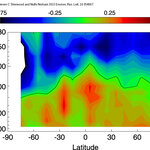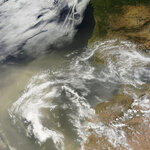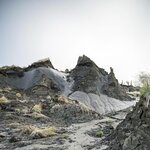Atmospheric

According to a new global-scale projection, terrestrial vegetation emits several million tons of extremely low-volatility organic compounds (ELVOCs) per year to the atmosphere, which affect cloud seeds via formation of low-volatility vapors. These oxidation products of compounds such as monoterpenes results in an increase of condensing vapors that can further form cloud condensation nuclei over the continents and have an influence on the formation of clouds.
The results show how a number of natural compounds, which together account for around 70 percent of the biological hydrocarbon…

Karin Heineman, Inside Science – Predicting and analyzing weather is a highly sophisticated scientific endeavor these days. But, it is also peppered with a good deal of lore.
We're here to debunk some popular weather myths.
Myth #1: Heat lightning, or the distant flashes of lightning you see in the sky (without hearing the clap of thunder) during the hot summer months, only occur because it is hot out.
Wrong. The truth is you're actually seeing lightning from a storm that's really far away. Since most severe thunderstorms often happen during hot summer months – the name "heat"…

Researchers have confirmed strong warming in the upper troposphere, known colloquially as the tropospheric hotspot, long expected as part of the global warming hypothesis.
Though the tropospheric hotspot appears in many global climate models, the inability to detect it has been used to suggest climate change is not occurring as a result of increasing carbon dioxide emissions.
The discovery was made by extending an existing data record and removing artifacts caused by station moves and instrument changes. This revealed real changes in temperature as opposed to the artificial…

A previously unknown dual mechanism slows peat decay and may help reduce carbon dioxide emissions from peatlands during times of drought, according to a new study. The naturally occurring mechanism was discovered in 5,000-year-old pocosin bogs in coastal North Carolina. Preliminary field experiments suggest it may occur in, or be exportable to, peatlands in other regions as well.
Peatlands are wetlands that cover 3 percent of Earth's land but store over 30 percent of the planet's total soil carbon. Left undisturbed, stored carbon can remain locked in their organic soil for millennia due…

Ethanol fuel refineries could be releasing much larger amounts of some ozone-forming compounds into the atmosphere than previous estimates.
Ethanol, a government mandated and subsidized renewable transportation fuel made from corn, now constitutes approximately 10 percent of the fuel used in gasoline vehicles in the U.S., according to the new study. The renewable fuel mandate was a successful environmental effort to increase the use of ethanol and other renewable fuels aims to reduce greenhouse gas emissions and petroleum imports, while encouraging development and expansion of the U.S.…

Making a series of relatively minor and realistic changes to UK diets would reduce UK diet-related greenhouse gas emissions by nearly 20 percent and extend average life expectancy by eight months, according to new model.
In one paper, authors estimated the greenhouse gas emissions associated with current UK diets and with diets modified to meet World Health Organization (WHO) dietary recommendations. In another paper, they estimated the impact these dietary modifications would have on the health of the UK population.
Current average diets for men and women in the UK do not meet WHO…

British people may not like blood rain but Sahara Desert dust is not traveling 2,000 miles over an ocean just to make their cars dirty - it also helps cool things down.
Researchers have analyzed the composition and radiative effect of desert aerosols during two episodes which simultaneously affected Badajoz (Spain) and Évora (Portugal) in August 2012 and found that it caused radiative cooling of the Earth's surface. Atmospheric aerosols (solid or liquid particles suspended in the atmosphere) are difficult to examine for various reasons - they remain in the atmosphere for only a short…

Everyone discusses ways to reduce carbon dioxide levels in the atmosphere (or not) but less considered is that there is a massive storehouse of carbon that has the potential to significantly alter the climate change picture.
Ancient carbon, locked away in Arctic permafrost for thousands of years, could transformed into carbon dioxide and released into the atmosphere by warmth.
The Arctic contains a massive amount of carbon in the form of frozen soil--the remnants of plants and animals that died more than 20,000 years ago. Because this organic material was permanently frozen…

Higher elevations around the world may be warming much faster than previously thought, according to a paper which reviewed elevation-dependent warming mechanisms such as loss of snow and ice, increased latent heat release at high altitudes, low-elevation aerosol pollutants that increase the difference in warming rates between low and high elevations, plus other factors that enhance warming with elevation in different regions, and in different seasons.
The problem is that although high mountains are the major water source for large numbers of people living at lower elevations,…

A new analysis of 1,000 years of temperature records suggests global warming is not progressing as fast as it was projected under the most severe emissions scenarios outlined by the Intergovernmental Panel on Climate Change (IPCC).
Natural variability in surface temperatures - caused by interactions between the ocean and atmosphere, and other natural factors - can account for observed changes in the recent rates of warming from decade to decade and these "climate wiggles" can slow or speed the rate of warming from decade to decade, or accentuate or offset the effects of increases…